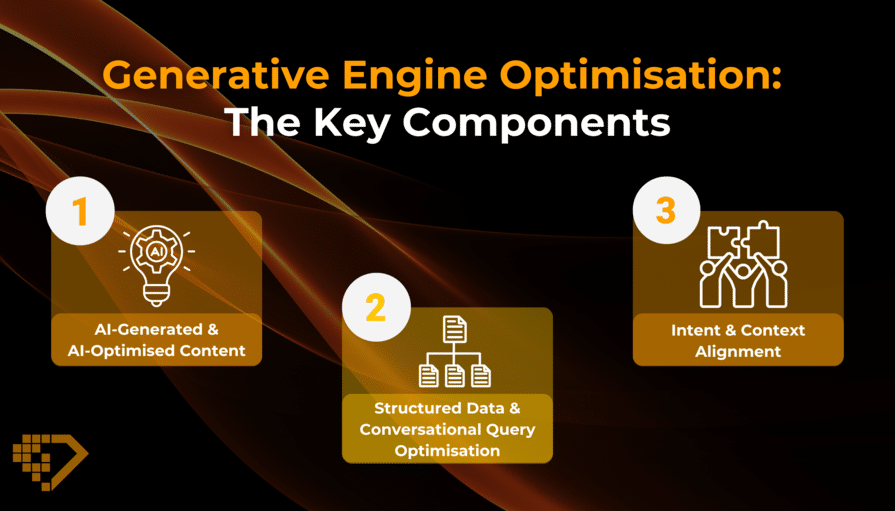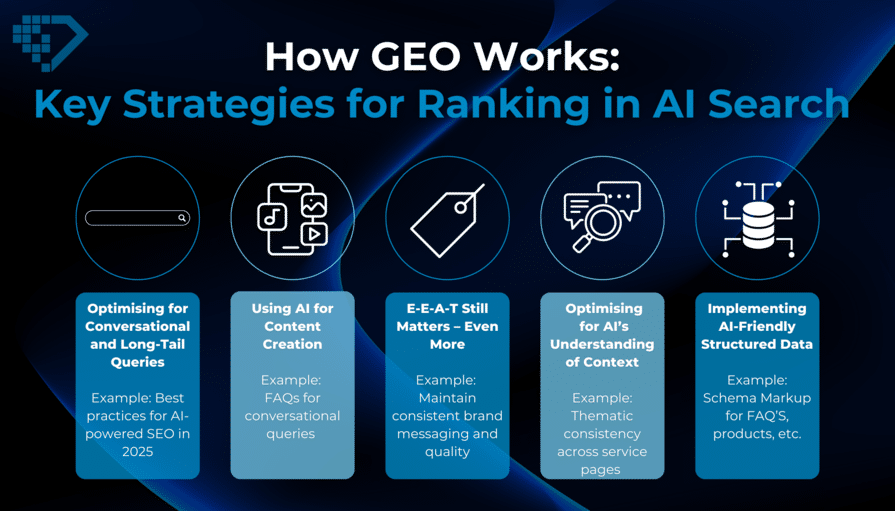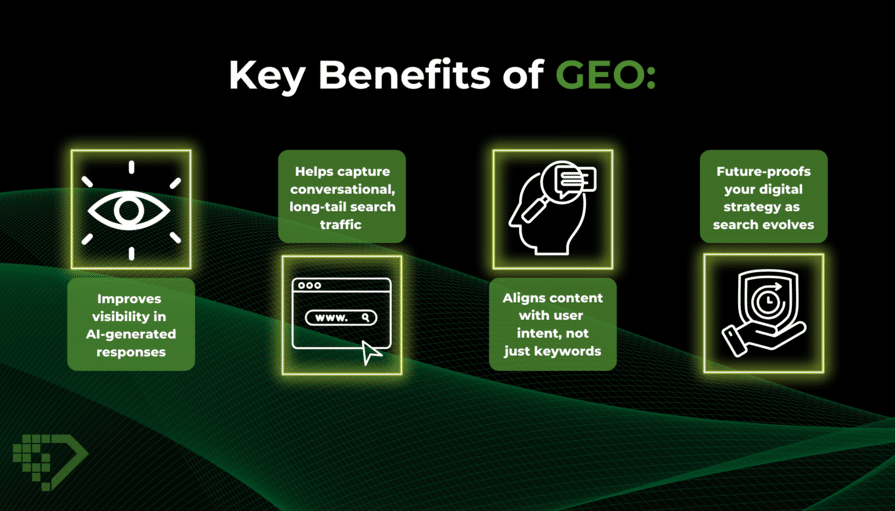Search has changed, and it’s not just about keywords anymore.
Thanks to the rise of AI tools like Google’s BERT, OpenAI’s ChatGPT, and Microsoft’s Copilot, the way people search (and how search engines respond) is evolving fast. We’ve moved from static keyword matching to AI-driven systems that understand language, context, and even intent.
This shift has made traditional SEO strategies less effective. Tactics like keyword stuffing, exact-match headlines, and backlink farming no longer cut it. That’s where Generative Engine Optimisation (GEO) – also referred to as Generative Engine Optimisation (GEO) – comes in.
GEO is an emerging approach that helps businesses rank in AI-powered search environments, where engines generate answers rather than just listing links. In this blog, we’ll break down what GEO is, how it works, and what it means for your business.
Understanding AI-Powered Search: The Basics
What is AI-Powered Search?
AI-powered search uses machine learning, natural language processing (NLP), and generative AI models to better understand and respond to user queries. Instead of looking for exact keyword matches, these systems interpret meaning and deliver contextually relevant answers.
Where traditional search engines relied heavily on crawling and indexing static web pages, AI-powered search goes a step further; it generates answers based on a blend of content, structure, and user intent.
Examples of AI-Powered Search Engines
We’re already seeing major search platforms integrate generative AI. Examples include:
Google’s Search Generative Experience (SGE), which delivers AI-generated overviews before standard search results.
Microsoft Bing with Copilot, which summarises answers from across the web.
ChatGPT’s browsing mode, which interprets complex questions and returns summarised insights.
These tools aren’t just curating—they’re creating responses. And that means your content needs to be optimised for how AI finds and uses it.
Why AI Search Matters for Businesses
For brands, this evolution means one thing: search visibility now depends on how well your content aligns with user intent, not just how many times you’ve used a keyword.
If AI tools don’t understand or prioritise your content, you’ll miss out on top-of-funnel visibility. To compete, you need to speak the language of AI. That’s where generative search engine optimisation comes in.
What is Generative Engine Optimisation (GEO)?
Generative Engine Optimisation is the process of optimising your content, structure, and strategy for AI-powered search engines and systems that use generative models.
Unlike traditional SEO, which focuses heavily on rankings within SERPs (search engine results pages), GEO is about becoming the source AI turns to when generating answers.
Key Components of GEO:
- AI-Generated and AI-Optimised Content
Using tools like ChatGPT, Claude, or Gemini to create content designed to fit naturally into AI summaries and answer boxes. - Structured Data & Conversational Query Optimisation
Implementing Schema Markup and optimising for natural, question-based queries that mimic how real people search. - Intent & Context Alignment
Understanding the “why” behind a search and creating content that directly satisfies that user intent.
In short, GEO helps businesses rank not just on the web, but inside AI-generated answers.

How GEO Works: Key Strategies for Ranking in AI Search
1. Optimising for Conversational and Long-Tail Queries
AI search tools are designed to answer questions the way humans ask them. That means targeting natural, conversational phrases like:
- “How can small businesses use Generative Engine Optimisation?”
- “Best practices for AI-powered SEO in 2025”
- “What’s the difference between GEO and traditional SEO?”
These longer, intent-rich queries help you align with how users interact with AI tools and chatbots.
2. Using AI for Content Creation
Generative AI isn’t just changing how people search—it’s changing how we create. AI tools can help produce content that’s contextually rich, semantically structured, and aligned with AI-generated answers.
This includes:
- FAQs for conversational queries
- Product descriptions written with NLP best practices
- Snippets designed for featured boxes or voice search results
The key is balancing AI assistance with human insight, ensuring the content remains valuable, trustworthy, and unique.
3. E-E-A-T Still Matters – Even More
Experience, Expertise, Authoritativeness, and Trustworthiness (E-E-A-T) are still important in the world of GEO. In fact, they’re amplified.
AI systems use content signals, links, authorship, and brand credibility to determine whether your content should be included in generated responses. That means:
- Use bylines and bios that demonstrate expertise
- Back up claims with cited sources
- Maintain consistent brand messaging and quality
4. Optimising for AI’s Understanding of Context
AI tools evaluate entire content ecosystems, not just isolated keywords. So, think about:
- Contextual linking between blog posts
- Thematic consistency across service pages
- Clear headings and summarised takeaways
This helps AI connect the dots and boosts your relevance in response generation.
5. Implementing AI-Friendly Structured Data
AI search engines rely heavily on structured data to understand content. Add Schema Markup for:
- Articles
- Products
- FAQs
- How-To Guides
This improves visibility in AI-driven features like Google’s SGE or Bing’s snapshot results.
Overcoming Challenges in GEO
Adapting to Constant Change
Generative search is evolving rapidly. What works today may not work tomorrow. That’s why agility is key. Stay updated, test frequently, and be willing to pivot your strategy as AI capabilities shift.
Maintaining Quality Control
AI-generated content can be a double-edged sword. Done right, it saves time. Done poorly, it risks penalties or loss of trust. Always edit, fact-check, and refine AI-generated content to meet high editorial standards.
Preparing for the Future
GEO isn’t just a short-term trend, it’s a future-facing approach. Businesses that adapt early will gain a competitive edge in visibility, credibility, and lead generation.

Embracing the Future of Search
The rise of AI has completely reshaped the search landscape. Traditional SEO alone is no longer enough to remain visible in an increasingly intelligent search environment.
Generative Engine Optimisation empowers businesses to evolve with the times – to create content that speaks to both people and machines, to prioritise intent over tricks, and to maintain visibility in a world where AI is the new front door to the web.
Key Benefits of GEO:
- Improves visibility in AI-generated responses
- Helps capture conversational, long-tail search traffic
- Aligns content with user intent, not just keywords
- Future-proofs your digital strategy as search evolves

The Future Outlook: AI and GEO Are Just Getting Started
As AI continues to shape how people search, shop, and consume information, GEO will become a foundational pillar of digital marketing. Businesses that embrace it now won’t just adapt, they’ll lead.
Whether you’re a startup or an established brand, integrating GEO into your SEO strategy isn’t just smart—it’s essential.
Explore how Ruby Digital’s GEO and SEO services can help you stay ahead of the curve.
Because in the age of AI, the best answers win and GEO helps you become that answer.



